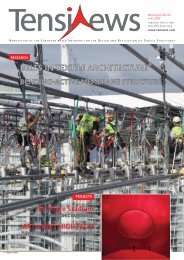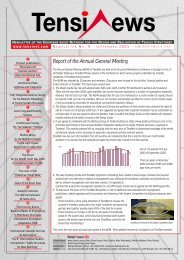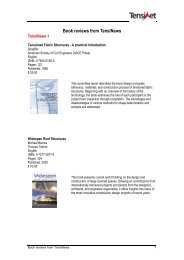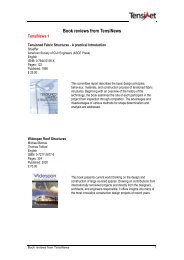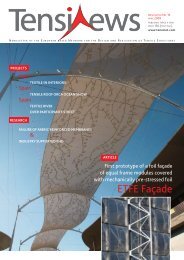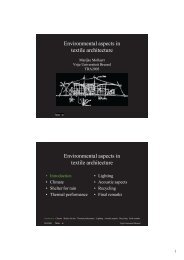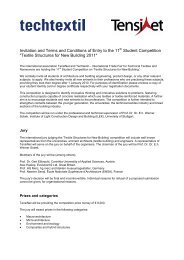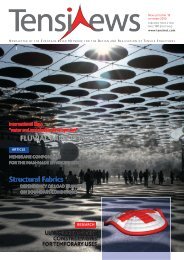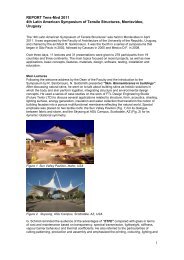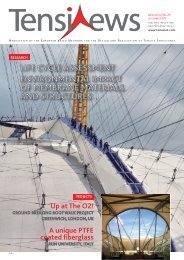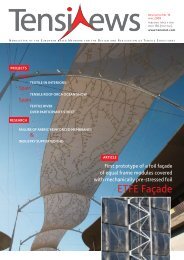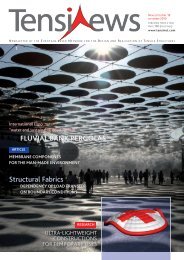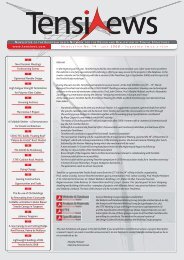TensiNews 13 - TensiNet
TensiNews 13 - TensiNet
TensiNews 13 - TensiNet
Create successful ePaper yourself
Turn your PDF publications into a flip-book with our unique Google optimized e-Paper software.
TENSINEWS NR. <strong>13</strong> – DECEMBER 2007<br />
12<br />
TENSINET ANALYSIS & MATERIALS WORKING GROUP<br />
BASIC PHILOSOPHY AND CALLING NOTICE<br />
This article proposes an initial basic philosophy<br />
for the new <strong>TensiNet</strong> Analysis and Materials<br />
Working Group and in so doing, calls for<br />
interested parties to become involved.<br />
The working group offers the opportunities<br />
to discuss existing and to propose new<br />
perspectives on the analysis of fabric<br />
structures. It especially encourages the<br />
consideration of the concept that materials<br />
testing and computational mechanics are<br />
mutually dependent and, by implication,<br />
not to be considered as independent.<br />
Current representations of fabric stress-strain<br />
behaviour are based on plane-stress<br />
assumptions, and tend to simplify the available<br />
data (e.g. use of secant elastic moduli). Young’s<br />
moduli and Poisson’s ratios are typically<br />
determined for each test so as to provide the<br />
best fit plane to limited scattered data points.<br />
These planar representations provided limited<br />
correlation with test data. The elastic constants<br />
do not comply with plane stress theory since<br />
coated woven fabrics are not homogeneous<br />
materials: they are composites with the<br />
interaction of orthogonal yarns making<br />
them act as a constrained mechanism.<br />
As an initial basis of a forum for discussion,<br />
a new approach to incorporating fabric test<br />
data in structural analysis was proposed at the<br />
<strong>TensiNet</strong> symposium in Milan (2007):<br />
use of direct correlation between pairs of<br />
stresses and strains. This avoids the inherent<br />
approximation in defining elastic constants or<br />
other parameters to quantify the fabric<br />
behaviour, requiring a fundamental change in<br />
the integration of material information into<br />
computational analysis.<br />
Representation & use of test<br />
results – plane stress<br />
Use of biaxial fabric test data in structural<br />
analysis is typically set within a plane stress<br />
framework using elastic moduli and interaction<br />
terms. The suitably of this approach for<br />
representing non-linear fabric behaviour has<br />
Table 1. Plane stress representation of fabric test data<br />
been assessed by comparing test data with a<br />
‘best fit’ plane stress model. Residual strain has<br />
been removed from the test results and the<br />
mean value of the loading and unloading<br />
curves have been calculated. This simplification<br />
approximates the inelastic hysteretic fabric<br />
behaviour with an elastic response and is<br />
necessary before trying to represent the fabric<br />
behaviour with a plane stress model.<br />
Plane stress theory defines a relationship<br />
between stresses and strains in thin continua<br />
using Young’s moduli and Poisson’s ratios.<br />
Applying plane stress theory to the principal<br />
warp and fill fabric axes gives:<br />
σw σf ν<br />
ε<br />
fw<br />
w = ——— - ————— , (1)<br />
Εw Εf σf σw ν<br />
ε<br />
wf<br />
f = ——— - ————— , (2)<br />
Εf Εw where ε = strain, σ = stress, Ε = Young’s<br />
modulus, subscripts w and f denote warp and<br />
fill directions respectively, and ν = Poisson’s<br />
ratio, defined as:<br />
νwf = fill direction strain caused by unit strain<br />
in the warp direction,<br />
νfw = warp direction strain caused by unit<br />
strain in the fill direction.<br />
The results for each pair of tests on one type of<br />
fabric have been combined into one data-set,<br />
and values of Young’s modulus and Poisson’s<br />
ratio have been determined to minimise the<br />
root-mean-square deviation of the plane stress<br />
values from the test results (Table 1).<br />
No constraints were imposed on the values of<br />
Young’s modulus and Poisson’s ratio. For each<br />
stress state tested the strains predicted by (1)<br />
and (2) have been compared with the test<br />
results (Table 1). The plane stress equations<br />
define planes in the stress-stress-strain space<br />
which can be used to visualise the<br />
representation of the test data (Figure 1 & 2).<br />
The overall correlation between the test data<br />
and plane stress representation is good. For<br />
PVC-polyester fabrics the variation between<br />
Figure 1. Test data for two test and best fit plane, Ferrari<br />
1202T PVC-polyester<br />
Figure 2. Test data for two test and best fit plane, Taconic<br />
Solus 1410 PTFE-glass<br />
the test data and plane stress model is only<br />
twice as much as the variation between the<br />
two repeat tests (Table1). The plane stress<br />
representation is only slightly less accurate for<br />
the PTFE-glass fabrics, but the fabric response<br />
is more consistent between tests making the<br />
mean 6 to 7.5% discrepancy between the test<br />
data and plane stress model more significant.<br />
The good fit of the plane stress model to the<br />
PVC-polyester test data can be attributed to<br />
the low level of crimp in the fabric, and the low<br />
tensile modulus of the polyester yarns. The low<br />
level of crimp (compared to PTFE-glass fabrics)<br />
results in less marked non-linearity. The low<br />
tensile modulus reduces the effect of the<br />
transition between crimp interchange at low<br />
load and yarn extension at higher loads. Whilst<br />
the mean deviation of the plane stress<br />
RMS strain difference RMS<br />
Fabric Material Young’s modulus Poisson’s ratio ‡<br />
for all test data points strain difference<br />
(Type † ) (kN/m width) (percentage strain, (percentage<br />
sd = standard deviation) of test strain range)<br />
Warp Fill νfw νwf Warp Fill Warp Fill<br />
Taconic Solus 1120 PTFE-glass (G5) 960.7 371.7 1.87 0.57 0.53, sd = 0.50 0.96, sd = 0.91 7.21 6.41<br />
Taconic Solus <strong>13</strong>00 PTFE-glass (G6) 1229.3 416.7 2.02 0.50 0.41, sd = 0.37 0.88, sd = 0.81 6.82 5.99<br />
Taconic Solus 1410 PTFE-glass (G7 ) 2246.9 1161.7 1.36 0.60 0.49, sd = 0.45 0.34, sd = 0.33 9.72 4.93<br />
Verseidag B18059 PTFE-glass (G6) 755.5 356.2 1.78 0.58 0.64, sd = 0.58 1.38, sd = 1.27 6.29 6.49<br />
Verseidag B18089 PTFE-glass (G6/G7) 852.2 341.5 1.91 0.54 0.75, sd = 0.70 1.29, sd = 1.23 7.93 6.61<br />
Ferrari 702T PVC-polyester (I) 592.0 342.9 1.01 0.35 0.20, sd = 0.18 0.33, sd = 0.30 5.35 4.47<br />
Ferrari 1002T PVC-polyester (II) 772.8 463.0 0.98 0.37 0.34, sd = 0.32 0.46, sd = 0.45 7.95 5.71<br />
Ferrari 1202T PVC-polyester (III) 877.9 506.0 0.79 0.42 0.51, sd = 0.47 0.46, sd = 0.42 8.08 5.23<br />
Ferrari 1502T PVC-polyester (IV/V) 1192.2 536.1 1.59 0.37 0.45, sd = 0.41 1.02, sd = 0.94 6.33 6.58<br />
Verseidag B6853 PVC-polyester (III) 825.7 341.6 1.20 0.38 0.50, sd = 0.45 0.66, sd = 0.60 7.54 5.18<br />
All values are determined from adjusted test data, i.e. with residual strain removed.<br />
‡<br />
According to plane stress theory Poisson’s ratio cannot exceed 0.5. However, higher values are required to model the high level of warp-fill interaction<br />
and large negative strains which occur in woven fabrics under biaxial load,<br />
νfw = fill direction strain caused by unit strain in the warp direction, νwf = warp direction strain caused by unit strain in the fill direction.




